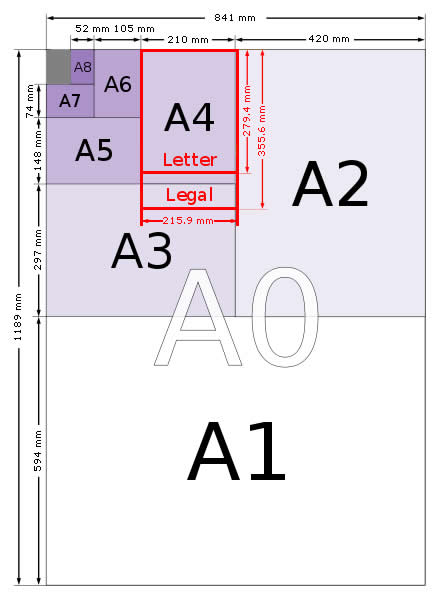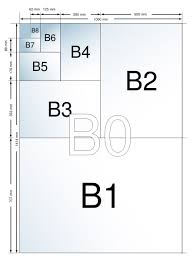Format
ISO sizes are the international standard for all paper sizes, within each set of sizes ( A,B etc.) all sizes work on a ratio of the biggest paper in that set. A1=half of A2 etc. Using these standardisations allows people to verbally communicate an idea clearer as they can use an iso size to give scale and context to a design proposal.
A sizes are the most commonly used in the UK. As the sizes work with a scale ratio this allows accurate scale mock ups of designs to be made that can communicate a clear idea of what the scaled up version will look like.

In my publication I want to include folded and scaled down models of the most common paper sizes with a reference to their size- such as a 1 pence piece that is scaled using the same ratio as the paper, I think that this would be helpful as it will give the designer a quick idea of what scale their design would work best on.
B sizes fill the halfway gap between each A size, e.g. B1 is halfway between A1 and A0. These sizes are less common but are still a possibility to use in design, B sizes are commonly used in envelopes and passports as well as in printing when they are used to define press sizes.
B sizes fill the halfway gap between each A size, e.g. B1 is halfway between A1 and A0. These sizes are less common but are still a possibility to use in design, B sizes are commonly used in envelopes and passports as well as in printing when they are used to define press sizes.

Newspapers have their own set of standard sizes designed for usability and specifically for what context that they will be used in, if a newspaper is designed to be read on the go with a quick run down of news it will be smaller and easier to handle- such as the Metro, whereas if the newspaper is designed to deliver a lot of information that is going to be read at home or in an office it will be printed broadsheet- such as The Financial Times
Stock
80# Gloss Text
Standard glossy paper stock, about as thick as a light magazine cover. The shiny finish provides an excellent opaque base for rich process color printing. This is our most popular type of stock for Brochure printing, Catalog Inserts, Flyers, Posters, etc.
100# Gloss Text
Similar to the 80# gloss text, but 25% thicker and heavier, for a more substantial feeling piece. Standard Uses: Brochures, Information Sheets, Self-mailers, Posters, Door Hangers, etc.
80# Dull/matte text
This stock is finely coated with a non-gloss finish. It provides an excellent opaque base for easy to read, crisp typography. Standard Uses: Brochures, Newsletters, Catalog Inserts, and Flyers, etc.
100# Dull/Matte Text
Thicker and heavier than our 80# Dull/Matte text for a more substantial feeling piece. Provides a non-glossy, opaque base for detailed, crisp printing.
80# Dull/Matte Cover
Our dull/matte cover is a thick 9 pt cover stock with a smooth, non-shiny coating. It is well suited for detailed, crisp printing without sacrificing the ability to easily write on the paper. Often selected with the 80# dull/matte text option for inside your catalog or booklet piece.
80# Gloss Cover
As a "cover" stock, this paper is stiff, about like a postcard or baseball card. This stock is coated with a glossy finish, making photographs and other images look beautiful. Standard uses: durable, heavy-weight Brochures, Catalog Covers, Product Spec Sheets.
100# Uncoated Cover
An option for business cards, rack cards and bookmarks. This bright white smooth #1 grade cover stock is 14 pt in thickness and matches the 70# text-weight stock we use for letterhead and envelopes.
120# Gloss Cover
We offer this high-quality, thick 14 pt stock on all of our card products. The glossy, coated finish makes photographs and other images look beautiful. We include aqueous coating to your four color sides for added protection and shine.
120# Dull/Matte Cover
Our dull/matte cover is a thick 14 pt cover stock with a smooth, non-shiny coating. It is well suited for detailed, crisp printing without sacrificing the ability to easily write on the paper. An excellent choice for Business Cards, Postcards, Note Cards and Greeting Cards.
70# Uncoated Text
We exclusively offer 70# Lustre for stationery, envelopes and newsletters. This ultra-premium uncoated (non-glossy) white stock is guaranteed safe for desktop laser printing. Many common stationery stocks are not optimized for 4-color printing, so we have selected this for best results. Feels thick and substantial in your hands, and is the best type of uncoated paper stock available for full-color printing.
24# Uncoated and 28# Uncoated
This is a standard stock commonly used for envelopes, also called White Wove. The 28# is thicker and heavier than the 24#.
Aqueous Coating
We include this clear water-based coating at no extra charge when you select a paper with gloss finish. Aqueous provides a high-gloss surface that deters dirt, fingerprints and scuffmarks. It protects pieces such as postcards and brochures as they go through the mail and business cards as they ride around in people's pockets.
UV Coating
UV coating is a highly protective, ultra-shiny gloss coating that we apply over aqueous coating and then cure on a special machine using ultraviolet light. The solvent-free UV coating provides an extremely hard finish that's chemical and abrasion resistant. It makes details really pop! On deep colors, it results in a stunning, almost wet appearance. Perfect when you want an environmentally-friendly and durable piece with a richer, high-end look and feel.
NOTE: UV Coating cannot be used on the addressed side of mailed pieces.
There is a huge variety of stock, most printing companies offer a small selection of the stock they offer, here is a selection of some of the stock that is on offer at Moo.com, they have gloss and matte finished stocks that range from 200 to 600gsm




No comments:
Post a Comment